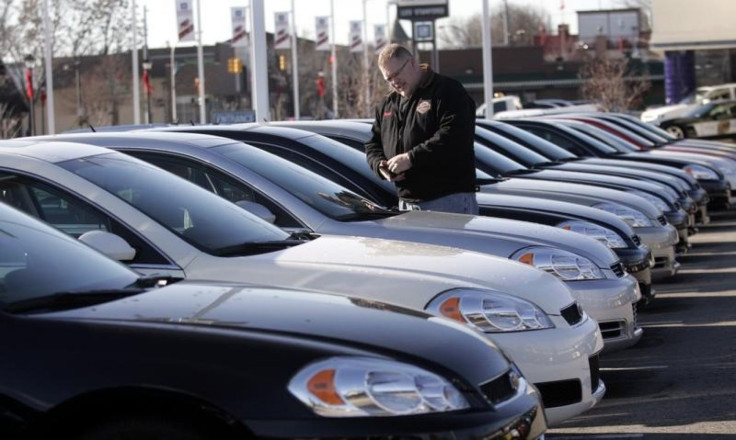Here’s Why High-Risk Subprime Auto Loans Are Growing, But Auto Loan Defaults Aren’t

To get an idea of how much Americans will scrimp to make their car payments, just look at the most recent data on U.S. loan defaults. For a fifth consecutive month in December, more consumers gave up paying their credit cards and mortgages while fewer bailed on their car payments, according to Experian.
The data is a snapshot of budget priorities that struggling Americans make. Ditching credit-card debt is less painful than losing a car to repo, especially for people in suburban areas where work commutes are longer, often to jobs that pay less than they did before the Great Recession.
Investors are betting that such car-dependence means subprime borrowers (people with low credit scores, who pay more for credit) will continue to make car payments a high priority in their monthly budgets. This bet that low-income households will make sacrifices elsewhere to keep their cars is helping fuel an increase in lending to high-risk borrowers.
“We have this big car dependency in the U.S. because the last 60 years of policies have been geared at building roadways to subdivisions. You need a car to get there,” said Ralph Buehler, associate professor of urban affairs and planning at Virginia Tech. “In some cities we now see wealthier people moving back to the inner city, and the poorer people are being pushed into very car-dependent territory.”
A 2011 study from the Brookings Institute showed that while urban populations have better access to public transport, and therefore don’t need to own cars, there are “potentially large accessibility problems for workers in growing low-income suburban communities.”
In other words, as access to public transportation options decline, car dependency increases, and this is happening outside of urban centers where high-skilled, well-paying jobs are concentrated. The poorer and further people are from the big city, the more they need a car to expand job opportunities.
“The country has been designed for cars, and because of that there is a reliance on cars,” said Bruce Belzowski, managing director of the Automotive Futures group at University of Michigan’s Transportation Research Institute. “Jobs are not concentrated in one area, and that means you need a car in many cases to get from one place to another.” The massive U.S. used car market, he added, “allows people from every income bracket to participate and to own a car that can get them to their jobs.”
Investor appetite for the long-term returns provided by high-risk subprime borrowers -- who often have to stretch out payments over longer periods -- has fueled the growth of subprime auto lending to near-pre-recession levels, according to the New York Federal Reserve.
The wager, made by investors who purchase bonds backed by subprime auto loans, could go sour if the economy worsens and unemployment rises. The total auto loan delinquency rate has been hovering at around 0.5 to 0.6 percent, according to Equifax Credit Trends and Moody Analytics. But that figure measures all auto loans, including those to borrowers with higher credit scores.
A study from the National Bureau of Economic Research that looked at auto loans to a group of subprime borrowers (those with Fair Isaac credit scores of less than 500) from 2001 to 2004 showed that more than half of the loans defaulted.
According to a recent research note from Moody's, using data from Equifax credit-reporting, about 8.4 percent of subprime borrowers who took out loans in the first quarter of 2014 had missed car payments by November of last year. That's close to the highest level since 2008, when these delinquencies topped 9 percent during the Great Recession.
Lending to these high-risk car-dependent borrowers is rising as investors feast on the high returns as lenders offer longer payment periods. "Americans are borrowing more to buy a car and so in order to make it more 'affordable,' they have to stretch out those loan terms," Chris Kukla of the Center for Responsible Lending told NPR in a report published Friday about the rise of subprime auto lending in recent years.
The National Independent Automobile Dealers Association expects new subprime auto lending contracts to continue to grow this year, to 7 million loans, the highest level since at least 2007 and over twice the level in 2009 when credit dried up during the Great Recession. Securities backed by auto loans bartered by groups including the automakers themselves, banks like Santander and hedge funds like Blackstone Group, have ballooned by more than 300 percent to $20.2 billion since 2010, according to Thomson Reuters data.
The New York Times reported Monday that this “booming business in lending to the working poor” is being urged by Wall Street’s appetite for higher returns on investment. Poor people pay higher interest on loans because they’re considered higher risk.
Anonymous sources quoted in the Times report said the U.S. Justice Department is investigating whether this demand for securities backed by subprime auto loans might be encouraging lenders to loosen up their requirements, such as not verifying income or job status of borrowers, knowing they can eventually pass the risk on to others, as happened in the 2008 housing industry collapse.
© Copyright IBTimes 2024. All rights reserved.






















